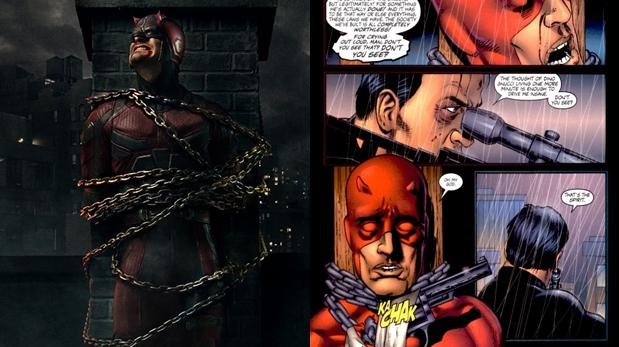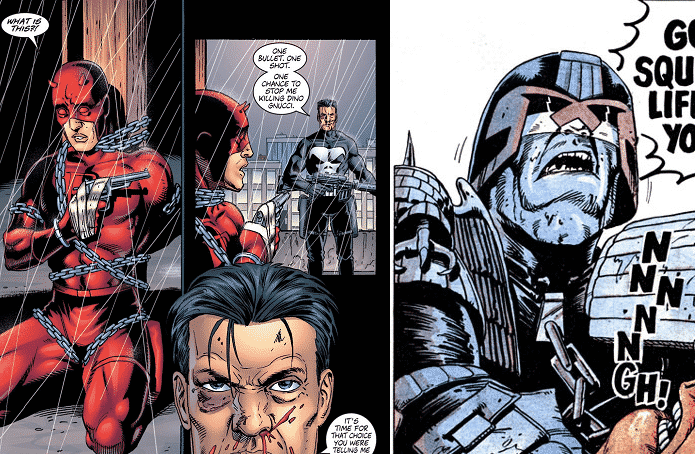If you’re a regular frequenter of websites such as the fine one I find myself lucky enough to write for (Remember, spread the word, tell your friends, folks…), you’ll have witnessed an unprecedented outpouring of grief in the online community this week for a chap named Steve Dillon.
You may not have known who he was, but if you’re in any significant way a fan of comics, then you’ll have been touched by his work. Steve Dillon was a British comic-book artist, with over 30 years of working in the industry under his belt. He was also the co-creator of a little strip named ‘Preacher’, which hit the big time this year after being successfully adapted for TV by Seth Rogen and Evan Goldberg.
In his lengthy career, Dillon contributed to a number of classic Marvel and DC publications, on both sides of the Atlantic, as well as being a significant contributor to 2000AD and their most famous creation, ‘Judge Dredd’. To put it in simple terms, if you’re a nerd, it will have been quite hard for you to have not clapped eyes on some of his artwork.
Dillon passed away in New York last week as a result of complications arising from a ruptured appendix. He was 54 years old, and still very much active at the time of his death. However we try and pay homage to him here at ScreenGeek, we acknowledge that we won’t be able to do him justice he deserves, but come with us, if you will, and let us show you how and where you may have encountered his works:
1. 2000 AD

Dillon’s first published artwork was in the spinoff comic which accompanied the famed sci-fi series ‘Doctor Who’ back in 1980. His talent was quickly recognised, and he was able to create a recurring character that would go on to be officially recognised within the Whovian Canon. In somewhat typical Steve Dillon fashion, his creation was somewhat colourful, being a chainsword-wielding Dalek-Killer by the name of Abslom Daak, a survivor or the Time Wars who was first encountered by the Eighth Doctor (That’s Paul McGann, to you and me….)
This in turn, led to the young Dillon being picked up by 2000AD in 1981. His first artwork for them was ‘Mean Arena’, which was a ‘Running Man’ clone in which criminals were pitted against one another in a stadium full of murderous bloodsports. It was a big success, and went on to run for 72 issues, even being rebooted and retconned in the 1990’s, and handed Dillon the keys to the bigger 2000AD characters.
Dillon contributed to a large number of projects, most prominently an extended run in Rogue Trooper with ‘The Hitman’ saga, and a number of whacky Judge Dredd stories including ‘Cry Of The Werewolf’ and ‘Alabammy Bumps’. They were vivid and crazy offerings, and his artwork would go on to keep Dillon with the company for an 11 year period.
2. Vertigo

The early 1990’s would see a mass exodus of British creative talent being tempted across the pond to America, as the big US comic-book companies sought to freshen up the decaying storylines of their major characters, and try to poach the limited available audience from their competitors. If you get the chance, try and watch ‘Future Shock – The Story Of 2000AD’, which explores the period in detail. Whilst Dillon does not appear in it, almost all of his fellow contributors do.
In 1993, DC were looking for characters and storylines to bolster their Vertigo imprint. One of the existing properties they sought to employ was a supporting character from their ‘Swamp Thing’ comics who went by the name of John Constantine. Originally created by the legendary Alan Moore (Watchmen), the rebellious English warlock was re-branded as ‘Hellblazer’, and has been running in some shape or form right up until present day, even recently spawning a short-lived TV adaptation.
One of the main contributors on the comic at that time was Garth Ennis, a deeply political Northern Irish writer, who had also been working at 2000AD alongside Dillon. The two had worked together on a number of Judge Dredd projects which examined the fate of Ireland in the Dreddverse. Their work was deeply satirical, colourful, and bloody, and was a natural fit for the Hellblazer imprint. Of particular note was the ‘Emerald Isle’ storyline, which saw the future Ireland dominated by potato-gun toting hitmen and an industry of sustainable singing marine life.
Dillon drew for about 20 installments of Hellblazer, with Ennis writing for all of these. Included in this period was the ‘Tainted Love’ storyline, in which Constantine is forced to do some heavy reflection and soul searching as he takes on a Vampire Lord that has stalked his family for generations. It was this success of marrying politics, religion and the supernatural that would in turn lead Ennis and Dillon to go on to create their own imprint.
3. Preacher

Two years after their run on Helblazer, Ennis and Dillon conceived an entirely new character to pitch to Vertigo. It was scandalous, deliberately designed to shock and court controversy. It was also crafted with the direct intention of being converted from page to screen, a dream that was recently realised in spectacular fashion. That character was Jesse Custer, AKA Preacher.
Ennis took all the naturally occurring issues from his Northern Irish background and channelled them into the character of the morally-ambiguous lapsed priest. The 66 episode slog, which would run from 1995 to 2000, was crammed full of swearing, sex, and senseless slaughter. It’s no small wonder it’s taken 16 difficult years to achieve their vision of adapting it for TV.
Essentially a road trip, where the three deeply flawed lead characters (including an alcoholic vampire) reminisce their troubled backgrounds whilst encountering all manner of religious horror, the comic was a massive success, with the trio’s search for God becoming arguably Vertigo’s most popular character of all time. Its gun-slinging religious style has been cited by Steven King as a heavy influence on his ‘Dark Tower’ series, which is also currently filming. And it was all illustrated, in glorious Technicolor, by Steve Dillon.
4. Deadpool

With the natural conclusion of ‘Preacher’, Dillon successfully made the jump from DC to Marvel, and started out with a lengthy run on the ‘Marvel Knights’ variant. This imprint was deliberately designed to be darker and edgier than the mainstream Marvel publications, a dark and nightmarish environment that played out in shadowy back alleys and warehouses. It’s antiheroes were flawed and impulsive, the kind of people who would never receive an invite to the Avengers, but have since gone on to become massively popular as the company have advanced outwards into mainstream media. It was one of these characters that would ultimately define Dillon’s career with Marvel, Frank Castle. But not until after he had continued his contributions to the edgier side of Marvel on other publications.
Two years before Marvel Studios exploded onto the scene with ‘Iron Man’, the company were building on the popularity that Hugh Jackman’s version of Wolverine had managed to generate in the X-Franchise, and sought to ret-con the character’s backstory with the ‘Wolverine: Origins’ storyline (not to be confused with the subsequent car-crash of a movie). One of the installments of this run would see Wolverine stalked and abducted by a then lesser-known member of the Weapon-X programme, Deadpool. Whilst hardened Marvel fans knew exactly who Wade Wilson was, it fell to Dillon to present him to a growing new audience.
With artwork that focused heavily on the facial expressions of the protagonists, Dillon illustrated a typically screwball caper where Wilson abducted Logan on the say-so of his illegitimate son, Daken. Cue classic Deadpool hallucinations, madcap ambushes and utterly insane booby traps, with a heavy slice of emotional heft thrown into the mix. It was a relationship with the character that would travel from ‘Origins’ into the newly created ‘Thunderbolts’ line-up in 2013. That publication was founded on Thunderbolt Ross’s hastily formed response to X-Force, and saw a red-themed band of antiheroes blackmailed into becoming the unofficial sword-arm of the US government. A kind of A-Team, but with deeper mental health issues.
Dillon was given the task of drawing the initial run of the series, again bringing his delightfully damaged version of Deadpool to the party, to be reunited with his cynical and deadpan portrayal of Frank Castle. It was shooty. It was stabby. It was explosive, and it was beloved by the fans, adding to the popularity of characters who had been mishandled in past attempts to bring them to the screen. And it in no small way contributed towards securing bright futures for both Deadpool and Punisher, who have enjoyed a tremendously successful 2016.
5. Punisher

For Punisher fans, the legendary MAX imprint remains the ‘Bible according to Frank Castle’. Since 2004, Marvel had created a superhero-free variant of the Marvel Universe in which Frank Castle faced off against evil in every corner and layer of society. It was saturated with graphic nudity, deaths that make ‘Game Of Thrones’ look tame, and deep satire on every aspect of American culture. And it was Steve Dillon’s version of Frank Castle that the company turned to in order to bring the MAX series to its natural conclusion.
Between 2010 and 2012, Dillon drew the final twenty two issues of the series. It’s hard to underestimate how important it was for the company to get this right. For twelve years, the series had gradually pulled the Punisher away from his deeply clichéd background and re-branded him as the social conscience of the American people. And he would go out with a bang. Dillon’s run saw Castle going head to head with the entirety of Wilson Fisk’s empire, as well as an utterly demented incarnation of Bullseye, who had been drafted in by Fisk to end his pressing vigilante problem.

If you can’t remember why this panel is familiar, here’s a reminder:

It doesn’t make for pretty reading, both in terms of the narrative, and the artwork. Children have their throats sliced open. Innocent families are abducted and slaughtered just for homework. Frank is slowly taken to pieces both physically and psychologically in a painfully drawn-out and heart-breaking journey, which ultimately culminates in his death. And it’s not a death he’ll be coming back from. It was a tour-de-force, and would see Dillon drafted back in to illustrate the modern-day run of The Punisher, which commenced in May 2016.
Steve Dillon was a key feature in the histories of a whole host of iconic comic-book characters who have now either achieved great cultural success, or are well on the way to doing so, and his efforts are not to be underestimated. Hopefully this surface examination of his career has made you realize that you know his work a little better than you thought. And if that’s not the case, then maybe its provided you with some pointers for material to seek out in order to expand your knowledge. Either way, it’s our meager little way of paying tribute to a true giant of the industry.
RIP, Kind Sir.

